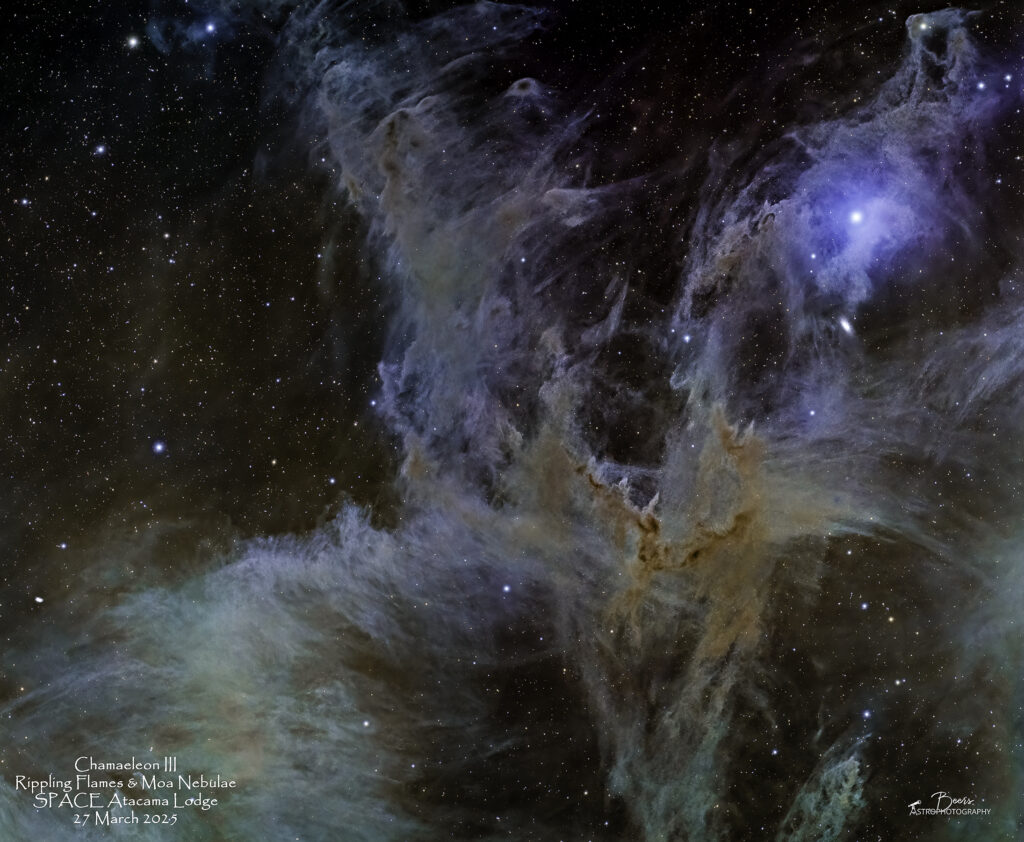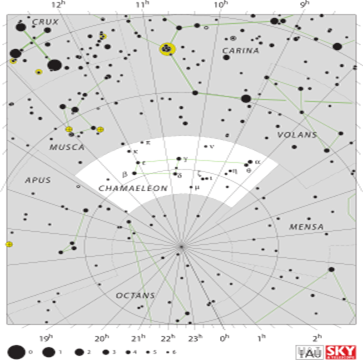
Fun facts
Chamaeleon constellation: Chamaeleon is a small constellation in the deep southern sky. It is named after the Chamaeleon, a kind of lizard. It was first defined in the 16th century.

STARS: There are four bright stars in Chamaeleon that form a compact diamond-shape approximately 10 degrees from the south celestial pole and about 15 degrees south of Acrux, along the axis formed by Acrux and Gamma Crucis. Alpha Chamaeleontis is a white-hued star of magnitude 4.1, 63 light-years from Earth. Beta Chamaeleontis is a blue-white hued star of magnitude 4.2, 271 light-years from Earth. Gamma Chamaeleontis is a red-hued giant star of magnitude 4.1, 413 light-years from Earth. The other bright star in Chamaeleon is Delta Chamaeleontis, a wide double star. The brighter star is Delta2 Chamaeleontis, a blue-hued star of magnitude 4.4. Delta1 Chamaeleontis, the dimmer component, is an orange-hued giant star of magnitude 5.5. They both lie about 350 light years away.
DSOs: The constellation contains several molecular clouds (the Chamaeleon dark clouds) that are forming low-mass T Tauri stars. The cloud complex lies some 400 to 600 light years from Earth and contains tens of thousands of solar masses of gas and dust. The most prominent cluster of T Tauri stars and young B-type stars are in the Chamaeleon I cloud, and are associated with the reflection nebula IC 2631. Chamaeleon contains one planetary nebula, NGC 3195, which is fairly faint. It appears in a telescope at about the same apparent size as Jupiter. {From: https://en.wikipedia.org/wiki/Chamaeleon}
Rippling Flames Nebula; Chamaeleon III Molecular Cloud: Lurking around the Southern Celestial Pole are these dark clouds and bright reflection nebulae. These are telltale signs of young stars and active star formation. They lie a mere 650 light-years away. Regions with young stars were identified as dusty reflection nebulae from the 1946 Cederblad catalogue. The Rippling Flames nebula is the central portion of the Chamaeleon molecular cloud complex. The irregular galaxy IC 3104 can be seen lurking in the background, partially hidden by clouds. {From: https://andysastro.com/2023/12/09/rippling-flames-nebula/}
Chamaeleon III complex contains a series of serpentine shapes that appear like rippling flames along the edge of a fire. These shapes are very reminiscent of the branches of a Kaizuka Tree (Kaizukaibuki – Juniperus chinensis). The Rippling Flames lie at the feet of the Moa in a south-eastern direction. {From: Imaging the Southern Sky; Stephen Chadwick and Ian Cooper; pp. 278-280}
Moa Nebula; Chamaeleon III Molecular Cloud: The Moa is the brightest and easiest of the Chamaeleon II and III nebulae to find. The chest is marked by Beta Chamaeleontis while the head is marked by the magnitude 8.0 star HD 106248. The Moa’s cranium is a well defined edge like a shockwave front that tapers off to form the beak.
The Moa’s back curves off in another apparent shock front to the east of Beta Cha. IC3104, a small elliptical galaxy just south of Beta Cha, makes the perfect Moa’s egg. Similar in appearance to the other great southern birds the Emu, Rhea and Ostrich, the Moa lived in magnificent isolation to become the largest bird that ever lived. {From: Imaging the Southern Sky; Stephen Chadwick and Ian Cooper; pp. 275-277}
Distance: 650 light years
Apparent dimensions: (Field size of Chadwick&Cooper images)
Moa Nebula: 1.7° x 1.4°
Rippling Flames Nebula: 2.2° x 1.5°
Constellation: Chamaeleon
Other Designations: Chamaeleon Region
{From: Imaging the Southern Sky; Stephen Chadwick and Ian Cooper; pp. 275-280}
Capture & Processing Notes
This was the first image of the Chile Atacama Desert 2025 trip, after a VERY long two-days of travel. Since I hadn’t had much sleep over the time period 25Mar2025, 1000MDT (when we (Paul and I) left home for the COS airport) and 27Mar2025, 0900CDT (when we (Jan, Dave, and I) arrived at the Atacama Lodge), I decided to image a target that would only have me getting up once during the night – so the Chamaeleon constellation targets it was! I decided to start with the Rippling Flames and Moa Nebula mosaic, where I could switch between tiles during the meridian flip – killing two birds with one stone (and one awakening during the night).
After a nap and a trip into San Pedro de Atacama for lunch (at the Tilar restaurant next to the Vincente Supermercado), Dave and I set up the telescope behind Lodge #1, very close to where I’d set up last year. I laid down to take a nap, setting an alarm for 19:00CDT. At that point, I set up the battery and ran through all the “new location” start-up process steps. I was done with all of that, so we had a bit of time before it was going to be dark enough to start the imaging (polar alignment) process. So, we all walked over to pay a short visit to our neighbors in Lodge 3&4 – turned out to be 5 guys from Canada, friends through their Astronomical League club. While we were visiting with them, Alain drove up on his bicycle to talk about, interest in and scheduling of, the star tours. While he was there, I asked for assistance with polar alignment like he’d done last year. He was about to have his first of two tour groups show up, so didn’t have time, but promised to check back at the end of the tours if we were still struggling with it! He referred us to the blog on the spaceobs.com website where there is a section on how to polar align in the Southern Hemisphere – giving us a brief talk through before he darted off for his tours and we retired to the telescope to attempt to get the sequence started.
Dave and I brought up Alain’s website and did a quick read through. We fiddled around with Alain’s method as well as the YouTube video method that used the Southern Cross and two bright stars below it to navigate to Sigma Octantis, but after fiddling around with both those method for awhile I told Dave “even if we find it in the sky, I need to find it in the Polemaster screen.” So, we turned our attention to finding the illusive σ Oct (Sigma Octantis or Polaris Australis) on the Polemaster screen. We used Dave’s phone displaying the star map from Alain’s blog. There was a three star grouping to the east of the trapezium with σ Oct. We discovered that if we moved that group of stars off to the far east (right side – don’t really know what direction that is in the sky) of the Polemaster screen we could use that to guide us to the trapezium containing σ Oct. It took us about two hours to get the mount polar aligned – Dave’s help was crucial throughout the process – he was the one who spotted σ Oct and its neighbors (and earned a big hug)!
The rest of the start-up went as usual. I got the sequence started at 22:16CDT. Executed the meridian flip at 02:24CDT. During the meridian flip, I also turned off Tile #1 in the sequence plan, so that it would start up by capturing Tile #2. When I terminated the sequence, the mount returned to home position of 180° instead of 90° as it had last year. PHD2 showed a very tight grouping, slightly east of center throughout the Tile #1 imaging. Disconnected all the equipment, recycled power and started back up on Tile #2 throughout the rest of the night.
Sequence Plan (27Mar2025): Gain 158, Offset 30, Temp 0°C;
Tile#1: 47x5min. Captured 27Mar2025, 22:16CDT – 28Mar2025, 02:32CDT. Total: 3:55hrs.
Tile#2: 45x5min. Captured 28Mar2025, 02:51CDT – 06:57CDT. Total: 3:45hrs.
Mosaic: (deleted last exposure captured on tile#2, since there was too much light in the image (captured after the start of astronomical twilight at 06:51CDT)): 91x5min. Captured 27Mar2025, 22:16CDT – 28Mar2025, 06:52CDT. Total: 7:35hrs.
Processing summary: Captured in SGP, stacked tiles and then created mosaic in APP (Adaptive Airy), star removal with Starnet++, processing with LR/PS
Equipment
Equipment: All equipment controlled by HP Probook running Sequence Generator Pro v4.4.0.1339.
- Imaging (ASI2400-SC): ZWO ASI2400MC imaging camera; (Southern Cross) Askar FRA600 108mm f/5.6 Quintuplet Petzval Flat-Field Astrograph
- Autofocuser: ZWO EAF Electronic Automatic Focuser – Standard (EAF-5V-STD)
- Mount: Rainbow Astro RST-135E (controlled by iHubo ASCOM driver)
- Polar alignment: QHYCCD camera (controlled by Polemaster for polar alignment)
- Autoguiding: Orion 60mm Multi-Use Guide Scope with Orion StarShoot AutoGuider Pro Mono Astrophotography Camera (controlled by PHD2)
Summary
Captured: 27Mar2025, 22:16 Chilean Daylight Time (CDT) – 28Mar2025, 06:52CDT. Total: 7:35hrs
Shooting location: San Pedro de Atacama Celestial Explorations (SPACE) Atacama Lodge, Chile
Equipment: Southern Cross on Rainbow Astro RST-135E
Processing summary: Captured in SGP, stacked tiles and then mosaiced in APP (Adaptive Airy), star removal with Starnet++, processing with LR/PS
